Summary: Haute couture refers to high-end fashion that is custom-made and tailored specifically for individual clients. It is known for its exquisite craftsmanship, attention to detail, and use of luxurious materials. Haute couture garments are created by skilled artisans and are considered to be works of art. The industry is regulated by the Chambre Syndicale de la Haute Couture in Paris, which sets strict criteria for designers to be recognized as haute couture houses. Despite its limited clientele and high costs, haute couture continues to be an important part of the fashion industry, influencing trends and showcasing the creativity and skill of designers.
What is Haute Couture?
Haute couture, a French term meaning “high sewing” or “high dressmaking,” refers to the creation of custom-made, high-end fashion garments. Haute couture pieces are meticulously crafted by skilled artisans, using the finest materials and techniques. These garments are made to measure for individual clients, ensuring a perfect fit and personalized design.
The History of Haute Couture
Haute couture originated in Paris in the mid-19th century. Charles Frederick Worth, an English designer, is often credited as the father of haute couture. He established the first haute couture house in Paris in 1858 and introduced the concept of presenting seasonal collections to clients. Worth’s innovative approach to fashion revolutionized the industry and set the stage for future haute couture designers.
In the early 20th century, the Chambre Syndicale de la Haute Couture was established to regulate and protect the industry. The organization sets strict criteria for designers to be recognized as haute couture houses. These criteria include having an atelier in Paris with a minimum number of skilled artisans, presenting a collection of at least 50 original designs twice a year, and catering to a private clientele.
The Haute Couture Process
The creation of a haute couture garment involves several stages. It begins with the designer’s sketches and ideas, which are then transformed into patterns and prototypes. Skilled artisans, including patternmakers, cutters, and seamstresses, bring the design to life using traditional sewing techniques and hand-finishing.
The materials used in haute couture are of the highest quality, including luxurious fabrics, intricate lace, and embellishments such as embroidery, beading, and feathers. Each garment is made with exceptional attention to detail, with hours of handwork dedicated to creating the perfect silhouette, fit, and finish.
The Significance of Haute Couture
While the number of clients who can afford haute couture is limited, its influence extends far beyond its exclusive clientele. Haute couture serves as a source of inspiration for ready-to-wear and high street fashion, influencing trends and pushing the boundaries of design. It showcases the creativity and skill of designers, who use haute couture as a platform to experiment with innovative techniques and materials.
Haute couture also plays a crucial role in preserving traditional craftsmanship and artisanal skills. The industry provides employment for highly skilled artisans, who pass down their knowledge and techniques from generation to generation. The intricate handwork and attention to detail in haute couture garments are a testament to the craftsmanship and artistry that goes into creating these pieces.
In conclusion, haute couture represents the pinnacle of fashion craftsmanship and design. It is a highly exclusive and luxurious form of fashion, tailored specifically for individual clients. Despite its limited clientele and high costs, haute couture continues to be an important part of the fashion industry, influencing trends and showcasing the creativity and skill of designers.












